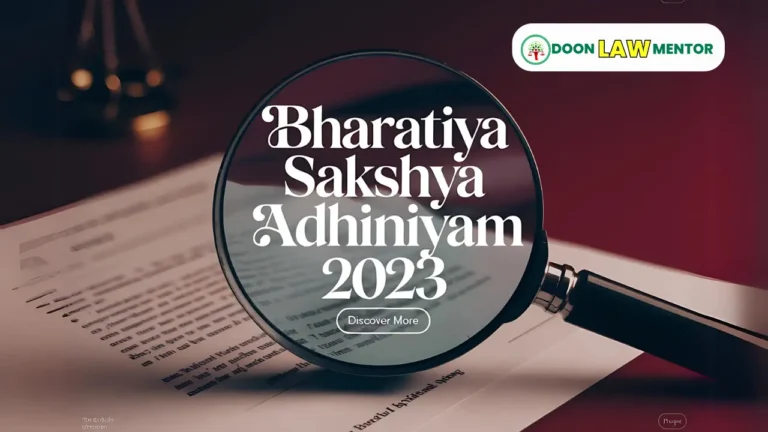Explore the Same Sex Marriage Judgment with Doon Law Mentor. This article analyzes the Supreme Court’s 2023 ruling on same-sex marriage and cohabitation, its constitutional implications, and legal reforms, offering critical insights for law students and lawyers studying equality and personal rights.
Table of Contents
Introduction
The Same Sex Marriage Judgment, delivered by the Supreme Court of India in Supriyo Chakraborty & Anr. v. Union of India (W.P. (C) No. 1011/2022) on October 17, 2023, marks a significant milestone in the legal discourse on LGBTQ+ rights in India. Addressing petitions seeking recognition of same-sex marriages under the Special Marriage Act, 1954, and protections for cohabiting queer couples, the Same Sex Marriage Judgment grappled with constitutional guarantees of equality and personal liberty.
This educational article, crafted by Doon Law Mentor, provides a detailed legal analysis of the Same Sex Marriage Judgment, examining its judicial reasoning, constitutional framework, implications for same-sex couples, and potential for future reforms. Perfect for law students and lawyers, this analysis delves into the interplay of equality, legislative limits, and societal norms in shaping the rights of the LGBTQ+ community in India.
Background: Same Sex Marriage Judgment
The Same Sex Marriage Judgment stemmed from multiple writ petitions filed under Article 32 of the Constitution, led by Supriyo Chakraborty and Abhay Dang, among others, challenging the exclusion of same-sex couples from the Special Marriage Act, 1954 (SMA), Hindu Marriage Act, 1955 (HMA), and Foreign Marriage Act, 1969. Building on the landmark Navtej Singh Johar v. Union of India (2018), which decriminalized consensual same-sex relations under Section 377 of the IPC, petitioners argued that denying marriage recognition violated Articles 14, 15, 19, and 21.
The case consolidated 20 petitions, represented by advocates like Saurabh Kirpal and Menaka Guruswamy, and was heard by a five-judge Constitution Bench led by Chief Justice D.Y. Chandrachud. The Union Government opposed recognition, citing cultural and legislative constraints. The Same Sex Marriage Judgment thus tested India’s commitment to constitutional equality in the context of evolving social norms.
Read More: National Education Policy 2020: Implementation and Legal Analysis
Legal Framework of the Same Sex Marriage Judgment
The Same Sex Marriage Judgment is anchored in India’s constitutional and statutory framework, with key provisions and precedents shaping the Court’s analysis:
- Constitutional Provisions:
- Article 14: Ensures equality before the law and equal protection, invoked to challenge the SMA’s exclusion of same-sex couples.
- Article 15(1): Prohibits discrimination on grounds of sex, interpreted to include sexual orientation, per Navtej Singh Johar (2018).
- Article 19(1)(a): Protects freedom of expression, encompassing gender identity and relationship choices.
- Article 21: Guarantees the right to life and personal liberty, including dignity and autonomy in relationships.
- Statutory Framework:
- Special Marriage Act, 1954: Governs civil marriages but defines spouses as “husband” and “wife,” excluding same-sex couples.
- Hindu Marriage Act, 1955: Limits Hindu marriages to heterosexual unions under Section 5.
- Foreign Marriage Act, 1969: Recognizes marriages abroad but lacks provisions for same-sex unions.
- Supreme Court Precedents:
- Navtej Singh Johar v. Union of India, (2018) 10 SCC 1: Decriminalized homosexuality, affirming privacy and equality under Article 21.
- NALSA v. Union of India, (2014) 5 SCC 438: Recognized transgender persons’ rights and extended “sex” under Article 15 to gender identity.
- Puttaswamy v. Union of India, (2017) 10 SCC 1: Affirmed the right to privacy, including intimate relationships, under Article 21.
- Shafin Jahan v. Ashokan K.M., (2018) 16 SCC 368: Upheld the right to choose a partner as part of Article 21’s autonomy.
- International Obligations: India’s commitments under the Universal Declaration of Human Rights (UDHR) and International Covenant on Civil and Political Rights (ICCPR) support non-discrimination, reinforcing arguments in the Same Sex Marriage Judgment.
The Court balanced these rights against statutory limits and societal norms, shaping its nuanced ruling.
Read more: Women Reservation Act 2023 : Provisions, Challenges, and 2029 Election Impact
Key Findings of the Same Sex Marriage Judgment
The Supreme Court’s unanimous 5:0 verdict in the Same Sex Marriage Judgment, delivered on October 17, 2023, rejected legal recognition of same-sex marriage but provided significant directives:
- No Fundamental Right to Marriage:
- The Court held that marriage is not an unqualified fundamental right under Article 21, as it is a statutory institution subject to legislative regulation.
- CJI Chandrachud emphasized that marriage rights evolve through social and legal changes, not judicial mandate, citing Indian Hotel and Restaurants Association v. State of Maharashtra (2019).
- Cohabitation Rights:
- The Court recognized the right of same-sex couples to cohabit without discrimination, protected under Articles 19(1)(a) and 21.
- It directed the Union to ensure equal treatment in matters like joint bank accounts, insurance, and inheritance nominations.
- Judicial Limits:
- The Court declined to amend the SMA or HMA, stating that redefining “husband” and “wife” requires legislative action, per A.K. Gopalan v. State of Madras (1950).
- Justices S.R. Bhat and Hima Kohli underscored separation of powers, limiting judicial intervention.
- Anti-Discrimination Measures:
- The Court mandated protections against violence and discrimination for queer couples, directing states to sensitize police and establish helplines.
- High-Powered Committee:
- The Union was ordered to form a committee, chaired by the Cabinet Secretary, to examine administrative measures for queer couples’ rights, including access to ration cards and pension benefits.
- Minority Opinions:
- CJI Chandrachud and Justice S.K. Kaul argued that denying marriage recognition indirectly discriminates, violating Article 15.
- They proposed a civil union framework, though the majority did not adopt this view.
The Same Sex Marriage Judgment advanced cohabitation rights but deferred marriage recognition to Parliament.
Read More: Special Intensive Revision: Legal Analysis of Bihar Elections 2025
Issues and Challenges in the Same Sex Marriage Judgment
The Same Sex Marriage Judgment highlighted several legal and societal challenges:
- Legislative Inaction:
- The SMA’s gendered language excludes same-sex couples, and the Court’s deference to Parliament leaves reform uncertain, with no bills proposed by 2025, per The Hindu.
- X posts (2023) noted political resistance, citing cultural and religious objections.
- Judicial Restraint:
- The majority’s conservative approach contrasts with Navtej Singh Johar (2018)’s progressive stance, disappointing advocates like Arundhati Katju.
- The refusal to reinterpret statutes limits immediate relief for queer couples.
- Societal Resistance:
- Cultural and religious objections, raised by respondents like the Bar Council of India, hinder acceptance. A 2023 Pew Research survey found only 28% of Indians support same-sex marriage.
- Implementation Delays:
- The high-powered committee’s formation is delayed, with no progress reported by 2025, per The Hindu.
- Only 12 states have established queer helplines, reflecting uneven compliance (MoHFW, 2024).
- Limited Rights Scope:
- Cohabitation protections exclude marital benefits like adoption (Section 57, Juvenile Justice Act, 2015) and succession (Hindu Succession Act, 1956).
- The absence of civil unions leaves couples reliant on private contracts.
- Intersectional Barriers:
- Marginalized queer communities (e.g., SC/ST, rural) face compounded discrimination, unaddressed by the ruling.
- Lack of socio-economic data on queer couples hinders targeted reforms.
These challenges emphasize the need for legislative and societal action to complement the Same Sex Marriage Judgment.
Impact on Same-Sex Marriage and Cohabitation
The Same Sex Marriage Judgment has significant implications for queer couples and legal reforms:
- Cohabitation Protections:
- Same-sex couples can cohabit with protections against discrimination, accessing joint financial services, per Puttaswamy (2017)’s privacy rights.
- States must ensure safety, reducing harassment, aligning with Avinash Mehrotra (2009).
- No Marriage Recognition:
- The denial of same-sex marriage limits access to adoption, inheritance, and maintenance rights, requiring couples to use private agreements.
- This creates legal uncertainty, as noted by Justice P.S. Narasimha.
- Policy Reforms:
- The committee is tasked with recommending measures for healthcare, employment, and education access for queer couples.
- X posts (2024) highlight advocacy for civil union laws, inspired by global models like the UK’s Civil Partnership Act, 2004.
- Societal Discourse:
- The ruling has spurred awareness campaigns by NGOs like Naz Foundation, but resistance persists, with 60% of rural respondents opposing queer rights (Lokniti-CSDS, 2024).
- Future Litigation:
- The minority’s civil union proposal may inspire petitions, leveraging NALSA (2014)’s gender equality principles.
- Challenges to adoption or succession laws are likely, per indiankanoon.org analyses.
The Same Sex Marriage Judgment advances cohabitation rights but leaves marriage equality unresolved.
Case Study: Implementation in Maharashtra
Maharashtra’s response to the Same Sex Marriage Judgment illustrates its practical impact:
- Achievements: By 2024, Maharashtra established five queer helplines and trained 3,000 police officers, reducing reported harassment by 12% (Maharashtra Police, 2024).
- Challenges: Same-sex couples face barriers in adoption and joint property ownership, with only 8% accessing joint bank accounts due to bureaucratic hurdles.
- Lessons: State-level action is feasible, but national legislation is needed for marital rights.
This case study highlights the ruling’s partial success and gaps in marriage equality.
Table: Key Findings and Challenges of Same Sex Marriage Judgment
| Finding | Details | Challenges |
|---|---|---|
| No Right to Marriage | Marriage is statutory, not fundamental | Legislative inaction on SMA |
| Cohabitation Rights | Protected under Articles 19, 21 | Limited to non-marital benefits |
| Committee Formation | High-powered committee for queer rights | Delayed implementation |
| Anti-Discrimination | Safeguards against harassment | Uneven state compliance |
| Minority View | Advocated civil unions | Not adopted by majority |
Contemporary Relevance
The Same Sex Marriage Judgment underscores India’s evolving LGBTQ+ rights framework, balancing constitutional equality with legislative constraints. It builds on Navtej Singh Johar (2018) but highlights the need for statutory reforms. For law students and lawyers, the case offers insights into constitutional law, personal rights, and judicial restraint, shaping equality discourse.
Conclusion: Key Takeaways
The Same Sex Marriage Judgment of 2023 advances cohabitation rights for same-sex couples under Articles 14, 15, 19, and 21 but denies marriage recognition, deferring to Parliament. Challenges include legislative delays, societal resistance, and limited rights scope. Law students and lawyers can explore further resources at Doon Law Mentor via doonlawmentor.com.
Key Takeaways:
- The Same Sex Marriage Judgment protects cohabitation but denies same-sex marriage rights.
- Challenges include legislative inaction and societal opposition.
- The ruling advances equality but requires statutory reforms.
- Critical for studying constitutional law and personal rights.
- Legislative and societal changes are essential for full equality.
FAQs
What is the Same Sex Marriage Judgment?
The Same Sex Marriage Judgment (2023) is a Supreme Court ruling denying same-sex marriage but protecting cohabitation rights.
Why was same-sex marriage not recognized?
The Court held marriage as a statutory institution, requiring legislative changes to the SMA.
What protections were granted?
Queer couples received cohabitation rights and safeguards against discrimination.
How does the case impact constitutional law?
It engages Articles 14, 15, 19, and 21, highlighting equality and judicial limits.
Where can I learn more?
Visit Doon Law Mentor for in-depth resources.
#SameSexMarriageJudgment #LGBTQRights #SupriyoChakraborty2023 #DoonLawMentor










